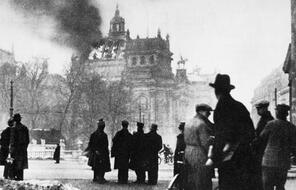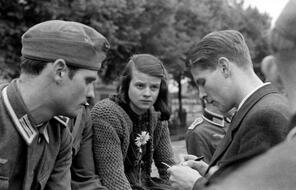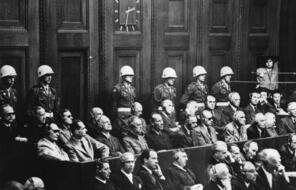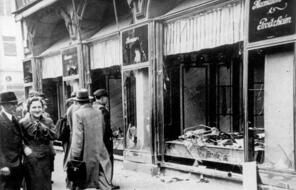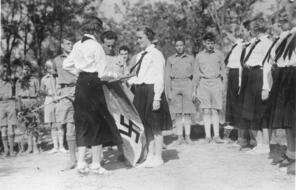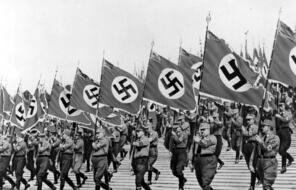Working Toward the Führer
Beginning in the 1920s, Hitler used the title Führer to refer to his position within the Nazi Party. Führer means “leader,” but to Hitler the Führer was not an ordinary leader of a political party or nation. He modeled his idea of the Führer on the leadership of Benito Mussolini, who led the Fascist movement in Italy and became that country’s dictator in the 1920s. Fascists were extreme nationalists who believed in the necessity for the absolute unity of the population behind a single charismatic leader and the supremacy of the good of the nation over the rights of individuals. Fascism originated in Italy but influenced political movements and governments around the world in the first half of the twentieth century. 1
Hitler believed that, as with all dictators, the Führer’s word was law; when he changed his mind, public policy changed. But the Führer’s charismatic leadership, his ability to express the will of the nation and to satisfy the desires of the masses, gave him a special ability to win followers and a duty to solve the nation’s problems and lead it to greatness. In the 1920s, Hitler described to one of his opponents within the Nazi Party the relationship he expected to have with party members: “For us the Idea is the Führer, and each party member has only to obey the Führer.” 2 In the 1930s, the Nazis tried to establish the same relationship between the Führer and the German people.
The Nazis carefully and relentlessly constructed Hitler’s public image. They spread pictures of Hitler in heroic poses in posters and in newspapers throughout the country. Hitler rehearsed his speeches, including his posture and gestures, to project strength and determination. As a result of these and other efforts, the Nazis were able to create “the adulation of Hitler by millions of Germans who may otherwise have been only marginally committed to the Nazi ideology." 3 As historian Ian Kershaw explains,
For the thirteen million Germans who voted Nazi in 1932, Hitler symbolized—chameleon-like—the various facets of Nazism which they found appealing. In his public portrayal, he was a man of the people, his humble origins emphasising the rejection of privilege and the sterile old order in favour of a new, vigorous, upwardly-mobile society built upon strength, merit, and achievement. He was seen as strong, uncompromising, ruthless. He embodied the triumph of true Germanic virtues—courage, manliness, integrity, loyalty, devotion to the cause—over the effete decadence, corruption, and effeminate weakness of Weimar society. Above all, he represented “struggle”—as the title of his book Mein Kampf advertised: struggle of the “little man” against society's “big battalions”, and mortal struggle against Germany’s powerful internal and external enemies to assure the nation’s future. 4
Once Hitler was in power, his public persona as the Führer of the German people encouraged both government officials and other Germans to take initiative on their own to help the nation realize the goals he expressed. In fact, he left it to others to figure out how to carry out policies and govern Germany. In a 1934 speech, a government official from the ministry of food, explained:
Everyone who has the opportunity to observe it knows that the Führer can hardly dictate from above everything which he intends to realise sooner or later. On the contrary, up till now everyone with a post in the new Germany has worked best when he has, so to speak, worked towards the Führer. Very often and in many spheres it has been the case—in previous years as well—that individuals have simply waited for orders and instructions. Unfortunately, the same will be true in the future; but in fact it is the duty of everybody to try to work towards the Führer along the lines he would wish. Anyone who makes mistakes will notice it soon enough. But anyone who really works towards the Führer along his lines and towards his goal will certainly both now and in the future one day have the finest reward in the form of the sudden legal confirmation of his work. 5
The dynamic this government official described occurred throughout the German government. Hitler stated goals and provided guidelines, and then he either appointed specific individuals to ensure that his goals were realized, or he let government bureaucrats and Nazi Party officials figure it out themselves. According to Kershaw, this process of “working toward the Führer” played out not just within the government but also across German society:
Individuals seeking material gain through career advancement in party or state bureaucracy, the small businessman aiming to destroy a competitor through a slur on his “aryan” credentials, or ordinary citizens settling scores with neighbors by denouncing them to the Gestapo were all, in a way, “working towards the Führer”. . . . Time after time, Hitler set the barbaric tone, whether in hate-filled public speeches giving a green light to discriminatory action against Jews and other “enemies of the state”, or in closed addresses to Nazi functionaries or military leaders. . . . There was never any shortage of willing helpers, far from being confined to party activists, ready to “work towards the Führer” to put the mandate into operation. 6
Connection Questions
- How did the Nazis create a public image of Hitler that won the support of so many Germans? What qualities did they emphasize? Why do you think those qualities were so appealing to Germans?
- What does the phrase “working toward the Führer” mean? How does it explain the relationship between Hitler and his associates and followers? Who made choices and took specific actions to bring about the transformation of Germany, according to Nazi ideology?
- What is obedience? Is obedience possible in the absence of a direct order to follow?
- According to Ian Kershaw, Hitler was the “linchpin” of the Nazi regime, and Nazism could not survive without him.
7
What evidence from this reading supports this view?
- Who spells out the goals for a community to which you belong? What opportunities do you and others have to help shape those goals or disagree with them? What roles do you and other members of the community play in achieving those goals?
- 1Robert Soucy, "Fascism," in Encyclopedia Britannica, accessed June 22, 2016.
- 2Jeremy Noakes and Geoffrey Pridham, eds., Nazism 1919–1945: A Documentary Reader, vol. 1: The Rise to Power 1919–1934 (Liverpool, UK: Liverpool University Press, 1998), 66.
- 3Ian Kershaw, “The Hitler Myth,” History Today 35, no. 11 (November 1985), accessed March 15, 2016.
- 4Ibid.
- 5Speech by Werner Willikens, State Secretary in the Ministry of Food, February 21, 1934, in Jeremy Noakes and Geoffrey Pridham, eds., Nazism 1919–1945: A Documentary Reader, vol. 2: State, Economy and Society 1933–1939 (Liverpool, UK: Liverpool University Press, 2000), 207.
- 6Ian Kershaw, “‘Working Towards the Führer’: Reflections on the Nature of the Hitler Dictatorship,” Contemporary European History 2, no. 2 (July 1993): 117.
- 7Ian Kershaw, “‘Working Towards the Führer’: Reflections on the Nature of the Hitler Dictatorship,” Contemporary European History 2, no. 2 (July 1993), 110.
Get the Handout
How to Cite This Reading
Facing History & Ourselves, “Working Toward the Führer”, last updated August 2, 2016.


